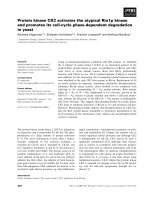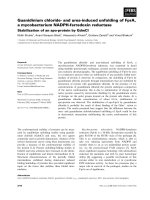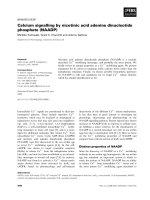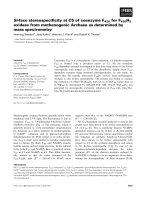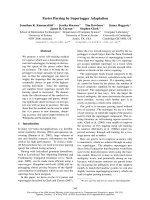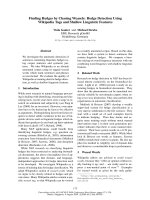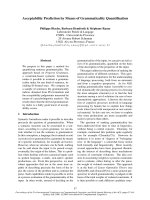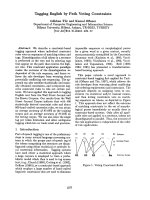Báo cáo khoa học: Protein stabilization by compatible solutes Effect of diglycerol phosphate on the dynamics of Desulfovibrio gigas rubredoxin studied by NMR docx
Bạn đang xem bản rút gọn của tài liệu. Xem và tải ngay bản đầy đủ của tài liệu tại đây (377.74 KB, 9 trang )
Protein stabilization by compatible solutes
Effect of diglycerol phosphate on the dynamics of
Desulfovibrio gigas
rubredoxin
studied by NMR
Pedro Lamosa
1
, David L. Turner
1,2
, Rita Ventura
1
, Christopher Maycock
1
and Helena Santos
1
1
Instituto de Tecnologia Quı
´
mica e Biolo
´
gica, Universidade Nova de Lisboa, Oeiras, Portugal;
2
Department of Chemistry,
University of Southampton, UK
Heteronuclear NMR relaxation measurements and hydro-
gen exchange data have been used to characterize protein
dynamics in the presence or absence of stabilizing solutes
from hyperthermophiles. Rubredoxin from Desulfovibrio
gigas was selected as a model protein and the effect of
diglycerol phosphate on its dynamic behaviour was studied.
The presence of 100 m
M
diglycerol phosphate induces a
fourfold increase in the half-life for thermal denaturation
of D. gigas rubredoxin [Lamosa, P., Burke, A., Peist, R.,
Huber, R., Liu, M.Y., Silva, G., Rodrigues-Pousada, C.,
LeGall, J., Maycock, C. & Santos, H. (2000) Appl. Environ.
Microbiol. 66, 1974–1979]. A model-free analysis of the
protein backbone relaxation parameters shows an average
increase of generalized order parameters of 0.015 reflecting
a small overall reduction in mobility of fast-scale motions.
Hydrogen exchange data acquired over a temperature span
of 20 °C yielded thermodynamic parameters for the struc-
tural opening reactions that allow for the exchange. This
shows that the closed form of the protein is stabilized by an
additional 1.6 kJÆmol
)1
in the presence of the solute. The
results seem to indicate that the stabilizing effect is due
mainly to a reduction in mobility of the slower, larger-scale
motions within the protein structure with an associated
increase in the enthalpy of interactions.
Keywords: chemical exchange; compatible solutes; protein
dynamics; rubredoxin; thermostability.
Protein stability, activity and dynamics are interrelated
issues with great importance not only in physiological
processes but also in protein engineering. The evolution of
protein structures towards extreme thermostability was vital
for hyperthermophiles, microorganisms thriving near the
boiling point of water. In general, the proteins of these
organisms are intrinsically resistant to heat denaturation.
However, hyperthermophiles also possess intracellular pro-
teins that are not particularly stable, implying the existence
of alternative strategies for their stabilization in vivo [1,2].
Hyperthermophiles accumulate high levels of charged
organic osmolytes in response to supra-optimal growth
temperatures, and this observation led to the hypothesis that
these compounds play a role in thermoprotection of
macromolecules in vivo [3,4]. This view is supported by
in vitro studies showing that these osmolytes protect proteins
against heat [1,5–8]. Nevertheless, the molecular basis for
this well established stabilization phenomenon remains
elusive.
Several possible mechanisms for protein stabilization
by osmolytes have been proposed [9–11]. Arakawa and
Timasheff [12,13] proposed a preferential hydration model
to explain protein stabilization by compatible solutes: solute
molecules are excluded from the protein surface, thereby
making denaturation entropically less favourable. In con-
formity, exclusion factors have been measured for a variety
of organic solutes and salts [14–16], however, the correlation
between exclusion factors and the degree of protection a
solute can bestow upon a particular protein is neither
unequivocal nor general [17,18]. These apparent inconsis-
tencies have sometimes been interpreted as being due to
specific protein–solute interactions [7,19]. In fact, the
magnitude of the stabilizing effect depends on the particular
solute–protein pair examined [5,8,19].
Another approach, proposed by Bolen and coworkers,
describes the stabilizing or destabilizing nature of inter-
actions between solutes and exposed groups in the protein
structure [20,21]. In this proposal, the stabilizing effect is
attributed mainly to a large contribution from interactions
with exposed backbone groups in a partially unfolded state,
with side-chain interactions modulating the specificity of the
effect. Overall, the interactions should cause a contraction
of the protein structure with a concomitant decrease in
internal mobility [21,22]. Indeed, the higher thermal stability
of hyperthermophilic proteins has often been correlated
with structure rigidification [23,24]. Structural data, both
from X-ray and NMR, on series of homologous proteins
show evidence for stronger local interactions and/or
improved packing of the polypeptide chain, which would
bring about a higher conformational rigidity [23]. More-
over, the lower catalytic efficiency observed in hyperther-
mophilic enzymes is usually explained by the decreased
Correspondence to H. Santos, Instituto de Tecnologia Quı
´
mica e
Biolo
´
gica, Apartado 127, 2780-156 Oeiras, Portugal.
Fax: + 351 21 4428766, Tel.: + 351 21 4469828,
E-mail:
Abbreviations: DGP, diglycerol phosphate; RdDg, Rubredoxin from
Desulfovibrio gigas.
(Received 4 July 2003, revised 22 September 2003,
accepted 2 October 2003)
Eur. J. Biochem. 270, 4606–4614 (2003) Ó FEBS 2003 doi:10.1046/j.1432-1033.2003.03861.x
flexibility of the active site, corroborated by the fact that
mutations increasing thermostability while maintaining
low-temperature activity are extremely rare [25]. In fact,
this rigidification has been revealed by H–D exchange
experiments [23,26]. However, this view was recently
challenged by the observation of relatively fast exchange
rates in the rubredoxin from Pyrococcus furiosus,themost
stable protein known to date [27]. In this context, assessing
the changes in the dynamic behaviour of proteins in the
presence of solutes is expected to shed light on the
stabilization phenomenon.
Desulfovibrio gigas rubredoxin (RdDg), a small iron–
sulfur protein with a hydrophobic core formed by the side
chains of six invariant residues, a three-stranded b-sheet,
and an exposed hairpin loop, was chosen as a model
protein. Its NMR solution structure was recently obtained
[28]. Also, RdDg is highly stabilized by diglycerol phosphate
(DGP), a solute accumulated by the hyperthermophilic
archaeon Archaeoglobus fulgidus [7,29]. Addition of 100 m
M
DGP yields a fourfold increase in the half-life for thermal
denaturation of RdDg, measured by UV–visible spectros-
copy at 90 °C[7].
We used NMR for these studies because it provides a
wide range of time-scales for the dynamic analyses.
Heteronuclear NMR relaxation data, from which general-
ized order parameters can be derived, provides a tool to
probe the dynamic behaviour of proteins in various
conditions [30–32]. Hydrogen exchange rates of labile
protons, such as the amide protons of protein backbones,
can also provide dynamic information on longer time-
scales. Amide protons that are buried inside the protein
structure and/or involved in hydrogen bonds require a local
structural opening to allow exchange with solvent protons
[33,34]. Therefore, the measurement of amide exchange
rates can be used to evaluate the relationship between
stability and the rigidity of several parts of the protein
structure [35,36].
Materials and methods
Rubredoxin production
Plasmid pRPPL1 [7] harbouring the RdDg gene was
digested with NdeIandEcoRI restriction enzymes. The
175-bp DNA fragment obtained was purified from an
agarose gel (2%) and inserted into vector pT7-7 [37]
previously digested with the same restriction enzymes. The
resulting construct was named pMSPL1. Escherichia coli
strain BL21(DE) was transformed with pMSPL1 and
grown in medium containing: KH
2
PO
4
,4.5gÆL
)1
;
K
2
HPO
4
,10.5gÆL
)1
;NaCl,0.5gÆL
)1
;Mg
2
SO
4
Æ7H
2
O, 0.5
gÆL
)1
;FeCl
3
Æ3H
2
O6mgÆL
)1
;U
15
N-(NH
4
)
2
SO
4
,2gÆL
)1
;
glucose, 4 gÆL
)1
; vitamin solution, 10 mLÆL
)1
; trace element
solution 10 mLÆL
)1
and ampicillin 100 mgÆL
)1
. One litre of
vitamin solution contained 500 mg aminobenzoic acid,
200 mg nicotinic acid, 100 mg pantothenic acid, 500 mg
pyridoxine, 100 mg thiamine, 200 mg thioctic acid, 200 mg
biotin, 100 mg folic acid and 100 mg riboflavin. The
trace element solution contains per litre: CaCl
2
,1.06g;
MnSO
4
Æ5H
2
O, 50 mg; CuSO
4
Æ5H
2
O, 8 mg; ZnSO
4
Æ7H
2
O
40 mg; NaMoO
4
Æ2H
2
O, 8 mg; CoCl
2
Æ6H
2
O, 8 mg; H
3
BO
3
,
6mg.
Transformed E. coli cells were grown until D ¼ 0.3 and
RdDg production induced with isopropyl thio-b-
D
-galacto-
side (IPTG; 25 lgÆL
)1
final concentration). At this time the
culture was supplemented with glycerol (4 mLÆL
)1
)and
ZnCl
2
(5 mgÆL
)1
final concentration) and incubated for 8 h.
Purification of the recombinant protein was performed as
described previously [7].
A yield of approximately 10 mgÆL
)1
of the zinc form of
RdDg uniformly labelled with
15
Nwasobtained.
Sample preparation
Purified uniformly
15
N-labelled RdDg (Zn form) was
concentrated and the buffer removed by ultrafiltration
using a YM3 membrane (Amicon). Two samples were
prepared in 10%
2
H
2
O at a final concentration of 4m
M
.
In one sample, DGP (potassium salt) was added to a final
concentration of 100 m
M
, while in the other sample KCl
was added to the same concentration. The pH was adjusted
to 6.9 in both samples and an antibiotic cocktail was added
with 70 l
M
ampicillin, 50 l
M
kanamicin, 50 l
M
rifampicin
and 50 l
M
chloroamphenicol.
For the
1
H–
2
H exchange experiments RdDg (Zn form)
was used at a final concentration of 1m
M
. KCl or DGP
was added to the protein in 2-mL Eppendorf tubes to a final
concentration of 100 m
M
, the pH was adjusted to 6 in the
unlabelledsamplesandto5inthe
15
N-labelled RdDg, and
the samples were freeze-dried. The dried samples were then
dissolved in
2
H
2
O, the pH readjusted (if necessary), and
placed in the spectrometer at the desired temperature. After
allowing a period for temperature equilibration, series of 1D
1
H(or2D
1
H-
15
N HSQC for the labelled samples) spectra
were acquired.
NMR spectroscopy
Unless otherwise stated all spectra were recorded at 303 K
in a DRX500 Bruker spectrometer equipped with a 5-mm
inverse detection probe head with internal B
0
gradient coils.
(Bruker, Rheinstetten, Germany). Temperature was con-
trolled using a Eurotherm 818 unit with a B-CU 05 cooling
unit. One-dimensional
1
H spectra for the exchange experi-
ments were acquired with 72 transients, and continuous
low-power water saturation during the relaxation delay of
2.0 s. A series of
1
H–
15
N correlation spectra was acquired
to measure the
15
N relaxation constants R
1
and R
2
,and
heteronuclear
1
H–
15
N NOE using the procedures outlined
in Kay et al. [38], modified to include a Watergate 3-9-19
water suppression scheme [39]. Values of R
1
and R
2
were
obtained by fitting the intensities (measured as peak-
volumes) over time to a single exponential decay. NOE
enhancements were taken from the mean value of three
integrations of peak volumes in spectra recorded with and
without proton saturation. The 2D
15
N–
1
H HSQC spectra
were recorded with standard Bruker pulse programs. In
these experiments 4096
1
H · 512
15
N data points were
collected using a delay of 2.7 ms for evolution of magneti-
zation in the INEPT transfer sequence. The 3D
15
N–
1
H
HSQC-TOCSY spectrum (4096
1
H · 32
15
N · 64
1
Hdata
points) was recorded using a delay of 2.7 ms evolution of
magnetization in the INEPT transfer sequence and a
TOCSY mixing time of 80 ms. The data were processed
Ó FEBS 2003 Effect of DGP on rubredoxin dynamics (Eur. J. Biochem. 270) 4607
with standard
BRUKER
software (Bruker). Polynomial
baseline corrections were applied in both dimensions of all
2D spectra.
Results
1
H and
15
N chemical shifts
The 2D
1
H-
15
N-HSQC spectrum of RdDg was assigned
with the aid of a 3D
1
H–
15
N TOCSY-HSQC spectrum and
published proton chemical shift data [28] (Fig. 1). Ambigu-
ities in signal assignment due to overlap in the
1
Hdimension
were solved through spin-system analysis of the 3D
TOCSY-HSQC spectrum, but three signals with AMX
type spin-systems could not be assigned unequivocally.
The temperature dependence of the
1
Hand
15
Nchemical
shifts was investigated in the presence of 100 m
M
KCl or
DGP by acquiring a series of
1
H–
15
N HSQC spectra over a
temperature span of 50 °C (from 30 to 80 °C). At 30 °C, the
addition of DGP had little or no influence on the proton
NH chemical shifts of RdDg. In fact, chemical shift
displacement upon solute addition seems random, with
most shift changes within experimental error, an average
value of 0.004 p.p.m., and a maximum value of 0.087 p.p.m.
(Phe30). The displacement of
15
N chemical shifts follows a
similar pattern, with an average value of 0.031 p.p.m and a
maximum value of 0.607 p.p.m. (Ala48). These results agree
with previous findings [28], in which DGP addition caused
no visible change in the proton spectrum.
The chemical shifts of amide protons in RdDg present a
small, linear dependence on temperature (up to 80 °C), both
in the presence of 100 m
M
KCl and DGP. The variation of
chemical shift with temperature seems random with average
slope of )0.0029 ± 0.0028 p.p.m.ÆK
)1
throughout the
protein, with the error given as the standard deviation of
the slopes. The segment 25–32 in the protein sequence shows
the largest temperature dependences with an average of
)0.0066 ± 0.0045 p.p.m.ÆK
)1
. The addition of DGP does
not significantly change this pattern. In fact, the difference
in chemical shift temperature dependence with or without
DGP is random and within the experimental error. Amide
15
N chemical shifts display both positive and negative
correlations with temperature, which seem unrelated to
protein sequence or residue type and present a relatively
small range of values (from 0.018 p.p.m.ÆK
)1
in Val5 to
)0.047 p.p.m.ÆK
)1
in Phe49). In some residues, such as Ile3,
Tyr11, Gly23, Lys25, Phe30 or Ser45, the chemical shifts
are temperature independent. Many of the plots of
15
N
chemical shift against temperature are nonlinear. This also
seems unrelated to protein structure or residue nature.
Upon solute addition, all signals still exhibit little tempera-
ture dependence and tend to maintain their positive or
negative correlations.
Relaxation data and dynamic parameters
Relaxation parameters were measured at 30 °C for 42 of the
47
15
N amide nuclei present in the protein (Fig. 2), and
analysed using the program Model-free v.4.01 [31,40]. The
diffusion tensor (D) and the rotational correlation time (s
m
)
were evaluated prior to analysis. The software package
R
1
R
2_
DIFFUSION
[31,40] was used to translate the centre of
mass of the mean structure of the NMR ensemble [28] to the
origin of coordinates, and to estimate D from T
1
/T
2
ratios.
Residues that might be undergoing conformational exchange
were identified from the condition: (ÆT
2
æ ) T
2,n
)/ÆT
2
æ ) (ÆT
1
æ
) T
1,n
)/ÆT
2
æ >1.5r andexcluded[41].Here,T
2,n
is the T
2
of residue n, ÆT
2
æ is the average T
2
,andr is the standard
deviation of (ÆT
2
æ ) T
2,n
)/ÆT
2
æ ) (ÆT
1
æ ) T
1,n
)/ÆT
2
æ.
The axially symmetric diffusion model best fitted the
experimental data, and the structure was rotated to its
principal axis for use in the model-free analysis. The
parameters, selected by extensive Monte-Carlo simulations
as described by Mandel et al. [31], are summarized in
Table 1. After model selection, both the correlation time
and the axially symmetric diffusion tensor were optimized
simultaneously with all other model-free parameters.
In the presence of KCl, there were five residues that did
not fit any model in the analysis; these are Tyr11, Tyr13,
Leu33, Gly43, and Ala44. Five residues also failed to fit any
model in the presence of DGP: Thr7, Val8, Ala16, Leu33,
and Val41. The rotational correlation time, s
m
, determined
in the final calculations, was 3.9 ± 0.2 and 4.6 ± 0.4 ns in
the presence of 100 m
M
KCl and DGP, respectively. These
values for s
m
are in agreement with the observed negative
NOE values and the small size of the protein.
Effective correlation times (s
e
) in the range of 20–70 ps
were found for 13 residues in 100 m
M
KCl (Fig. 3). In the
presence of DGP, 10 residues required the determination of
s
e
to fit the model. In both cases, most of these residues are
located in the hairpin loop region. Only two residues (8 and
46) required an R
ex
term for adequate fitting in the presence
of KCl, with values ranging from 0.8 to 4 s
)1
. When DGP
was present, six residues needed an R
ex
term (residues 24, 31,
32, 44, 49 and 51), but the fitted value is close to zero in all
six cases.
The values of the generalized order parameter, S
2
(Fig. 3)
do not display any particular trend over the protein
Fig. 1.
1
H–
15
NHSQCspectrumof
15
N-labelled RdDg (Zn-form) in the
presence of 100 m
M
KCl at 30 °C.
4608 P. Lamosa et al. (Eur. J. Biochem. 270) Ó FEBS 2003
sequence except for the small values in residue 2, which
agrees with the expected flexibility of the N-terminal
region of the protein. The difference of S
2
values in the
presence and absence of solute are shown in Fig. 4. Overall,
the average S
2
values tend to be higher in the presence of
DGP, but the average difference is only 0.015, and there is
no obvious trend towards segmental rigidification of any
part of the sequence. Instead, the whole protein (with the
exception of residues 14–18 and 37–45) tends to display
higher S
2
values in the presence of the solute (Fig. 4).
1
H–
2
H amide exchange
To evaluate the relative mobility and exposure of the several
segments of the protein sequence,
1
H–
2
H amide exchange
rates of
15
N labelled RdDg were measured at 40 °Cand
pH 5 by recording 2D HSQC spectra in
2
H
2
O as a function
of time and fitting the peak volumes to single exponential
decays (Fig. 5). The exchange rates of several amides were
inaccessible under these experimental conditions: 26 resi-
dues exchanged so rapidly that the signals were undetectable
at the start of the spectral acquisition, and nine residues gave
signals that remained almost constant throughout the
experiment, indicating half-lives greater than 250 h. The
slowly exchanging residues are clustered around the knuckle
that contains the metal centre, while the central region of the
b-sheet and the base of the hairpin loop display intermediate
exchange rates (Fig. 6). The most rapidly exchanging
residues are positioned in the hairpin loop, the protein
termini and the less structured region of residues 34–36 [28],
which is in agreement with a possible higher mobility of
these regions.
The addition of DGP produced a remarkable increase of
half-lives in the 17 amide exchange rates that were measured
both in its presence and absence at 40 °C, reflecting the
structural stabilization provided by this solute.
The EX2 exchange regime has been established in various
rubredoxins (as in most globular stable proteins) [27,42]. In
fact, EX1 reactions are rarely seen in stable proteins,
occurring mostly under the conditions used in some protein
refolding experiments [43–46]. Under the EX2 regime, the
exchange rates are described by Eqn (1):
k
ex
¼ K
op
k
ch
½Catð1Þ
where K
op
is the equilibrium constant for structural
opening reactions that expose the NH group [33]. The
term k
ch
[Cat] can be calculated from exchange rates in
unstructured peptides and used to obtain K
op
, and hence
a value of DG for the opening reactions [47]. Assu-
ming that the slowest exchanging residues (Val5,
Fig. 2.
15
N amide relaxation parameters of
RdDg as a function of residue number in the
presence of 100 m
M
KCl (A–C), or 100 m
M
DGP (D–F). (A,D) Longitudinal relaxation
time; (B,E) transverse relaxation time; (C,F)
heteronuclear NOE.
Table 1. Summary of parameters used to fit T
1
, T
2
and hNOE. S
2
is the
square of the generalized order parameter characterizing the amplitude
of the internal motions; s
e
is the effective correlation time for the
internal motions; R
ex
, is the exchange contribution to T
2
,andthe
subscripts f and s indicate fast and slow time scales, respectively.
Model
Optimized
parameters
Fitted residues in the
presence of
KCl DGP
1S
2
23 24
2S
2
and s
e
12 7
3S
2
and R
ex
13
4S
2
, s
e
and R
ex
13
5 S
2
s
, S
2
f
and s
e
00
Not fit – 5 5
Ó FEBS 2003 Effect of DGP on rubredoxin dynamics (Eur. J. Biochem. 270) 4609
Cys6, Thr7, Val8, Cys9, Tyr11, Tyr13, Cys39, Val41, and
Cys42), which are all located near the metal centre,
exchange via a single opening reaction, it is possible to
use the measured exchange rates at five temperatures
(between 50 and 70 °C) at pH 6, to obtain the tempera-
ture dependence for the DG of the structural opening
Fig. 3. Estimated model-free parameters of
RdDg as a function of residue number in the
presence of 100 m
M
KCl (A–C), or 100 m
M
DGP (D–F). (A,D) Generalized order
parameter; (B,E) effective correlation time;
(C,F) chemical exchange rate.
Fig. 4. Difference between the generalized or-
der parameters in the presence of 100 m
M
KCl
or DGP of RdDg. Only residues whose
parameters were calculated in both cases with
thesame(blackbars)orwithdifferent
dynamic models (grey bars) are included.
Fig. 5. Half-life values for the
1
H–
2
Hamide
exchange reaction in RdDg measured at 40 °C
in the presence of DGP (black bars) or KCl
(grey bars) at 100 m
M
. The broken bars rep-
resent the slowest exchanging residues with
half-life values higher than 250 h, which were
too long to be determined in the experimental
time frame.
4610 P. Lamosa et al. (Eur. J. Biochem. 270) Ó FEBS 2003
around the metal centre, that allows the exchange of
these amide residues to take place. In these residues,
DG displayed a linear dependence on temperature. Con-
sidering the experimental errors and the narrow range of
temperatures investigated, it is reasonable to treat DHas
constant, and use the Gibbs equation to obtain global
enthalpies and entropies for the opening reaction.
In the presence of 100 m
M
KCl the structural opening
reactions presented an average DG at 60 °Cof28.8±0.9kJÆ
mol
)1
,fromwhichaDHof143±23kJÆmol
)1
and DS of
0.34 ± 0.07 kJÆK
)1
Æmol
)1
can be derived. In the presence of
DGP an average DG of 30.4 ± 0.9 kJmol
)1
was found, and
a DH of 160 ± 23 kJmol
)1
and DS of 0.39 ± 0.07 kJÆK
)1
Æ
mol
)1
were calculated.
Upon solute addition a stabilization of RdDg took place
and an average positive DG of 1.6 kJÆmol
)1
can be observed
for the structural opening reactions that allow amide
exchange around the metal centre to take place. Gibbs free
energy vs. temperature plots result in two almost parallel
lines in the presence of KCl or DGP (Fig. 7), which suggests
that, in this case, the enthalpic contribution is more
important to the stabilization phenomenon than the
entropic term.
Discussion
Chemical shifts are sensitive probes of structural changes in
the mean position of atoms within a defined structure or
protein conformation. The presence of DGP caused no
significant alteration in
1
Hor
15
N chemical shifts or in their
temperature dependence. This means that, throughout the
temperature range investigated (from 30 to 80 °C), solute
addition leaves the mean protein structure unchanged. A
similar lack of change was observed in chymotrypsin
inhibitor 2 and in horse heart cytochrome c,wherethe
presence of 2
M
glycine produced no visible alteration in
proton chemical shifts [36]. These results support the view
that stabilizing compatible solutes exert their effect through
changes in solvent structure and/or subtle changes in the
dynamic properties of the protein rather than by changing
the structure of the protein itself. In fact, protein function
depends vitally on its structure and dynamics; if a stabilizing
solute induced substantial changes, it might hamper enzyme
activity, rendering the stabilizing effect useless.
The solute DGP is an effective stabilizer of RdDg [7],
however, like other solutes, it does not seem to alter protein
structure. The increased stability of proteins from hyper-
thermophiles, in comparison with their mesophilic homo-
logues, has frequently been interpreted as a consequence of
a number of mechanisms that improve internal attractive
forces and result in increased rigidity of protein structure
[48]. However, the terms rigidity or flexibility must be
regarded with caution, for there is no single measure of
flexibility. Proteins undergo a wide variety of motions on
vastly different time-scales; a protein may be rigid in the
nanosecond, and flexible on the millisecond time-scale.
Bearing this in mind, it is interesting to note that the
increased rigidity of RdDg upon addition of DGP is small in
the more rapid, low amplitude motions. The effect is mostly
in the longer time-scales and in the restriction of wider
concerted motions, which encompass the structural reac-
tions that allow protected amides to exchange with the
solvent. In fact, solute addition caused relatively small
changes in the relaxation parameters, in particular for T
1
,
which remained practically unaltered. T
1
relaxation meas-
urements carry information about motions with frequencies
of about 10
8
)10
12
Hz, while T
2
and NOE enhancements
also depend upon higher amplitude motional regimes in the
micro- and millisecond time scale [38]. Thus, solute addition
appears to have a greater impact on the wider motions, while
leaving the small high frequency fluctuations unchanged.
Recently, however, Wang et al. [49] argued that, in the
case of ubiquitin,
15
N relaxation measurements alone
underestimate the variations in backbone dynamics. If this
proves to be a general effect, and not just a peculiarity of
ubiquitin, it could mean that the variations in backbone
Fig. 6. Backbone of RdDg showing different time ranges for the
hydrogen exchange rates of amide groups: slow (dark-blue), medium
(mid-blue), and fast (cyan). Cysteine sulphur atoms are depicted in
yellow. The slowest exchanging residues, clustered around the metal
centre, are indicated by residue number.
Fig. 7. Temperature dependence of the average free energy of the
opening reactions that determine hydrogen amide exchange, in the
presence of 100 m
M
KCl (s)andDGP(d).
Ó FEBS 2003 Effect of DGP on rubredoxin dynamics (Eur. J. Biochem. 270) 4611
dynamics we have measured may be underestimated, which
in turn could explain why they are so small. Nevertheless,
the faster time-scales would still be the least affected by
solute addition, suggesting that the stabilizing effect oper-
ates via a higher restriction of the wider motions.
Most dynamic studies reported in the literature were
performed on proteins with about 100 amino acids, and
rotational correlation times of around 6–9 ns [30,38,50–52].
D. gigas rubredoxin has only 52 amino acids and the
smaller correlation time (3.9 ns was estimated in 100 m
M
KCl), higher average R
2
values and lower (more negative)
NOE enhancements [38,53] agree well with values from
other studies in view of the smaller size of RdDg. Studies in
which the dynamics of a protein are investigated in different
conditions invariably find increases in correlation times
upon ligand binding which are interpreted in the light of the
higher mass or bigger size of the complex [32,52,54]. In this
study, the presence of DGP was found to increase the
correlation time by 0.7 ± 0.6 ns. It is difficult to interpret
this effect as a mass variation, since binding of the solute
should cause more dramatic changes in the chemical shifts
than we observed. Although close to the experimental error,
a slight increase in correlation time would be consistent with
a higher solvent viscosity, brought about by solute addition.
The measured generalized order parameters (S
2
)for
RdDg are all above 0.7 (with the exception of Asp2), which
denotes a relatively rigid protein structure. The least ordered
parts of the NMR structure [28] are the N terminus and the
loop region. DGP addition leaves the overall picture
unaltered, but, with the exception of segment 37–45, there
is a trend towards generalized rigidification of the protein
(Fig. 4). Most residues that require the determination of s
e
to fit the model, with or without solute, are located in the
loop. Similar behaviour has been observed in the loop
regions or turns of E. coli topoisomerase I [52]. The average
s
e
value for these high frequency motions is also left almost
undisturbed by solute addition. The R
ex
term measures
wider motions than S
2
or s
e
and reflects ÔslidingÕ or
ÔbreathingÕ motions in protein structure [54,55]. In the
presence of 100 m
M
KCl only two residues required this
term for adequate fitting, which implies that these motions
are limited in RdDg. The addition of DGP required the
inclusion of R
ex
terms in six residues, but in all cases the
fitted value is near zero, suggesting that the solute
completely restricts concerted motions of groups on larger
time-scales.
The influence of DGP addition on the order parameters
of RdDg is of the same magnitude as the effect of ligand
binding reported in several studies. For instance, in
ketosteroid isomerase from Pseudomonas testosteroni the
active site residues show an average increase in order
parameters upon ligand binding of only 0.03, while order
parameters decrease in the rest of the protein [32]. In
4-oxalocrotonate tautomerase, binding of a competitive
inhibitor causes almost no change in average order param-
eters [54]. Most of the residues in E. coli topoisomerase I
suffer a decrease in order parameters upon DNA binding
while a small portion of the protein, directly involved in
binding, experiences an average order parameter increase of
0.04 [52]. In these studies, the increased mobility in large
sections of the protein was interpreted as a compensatory
effect for the unfavourable entropy associated with binding
site rigidification [32,54]. In this light, the generalized
increase in order parameters in RdDg upon addition of
DGP can be interpreted as a thermodynamically unfavour-
able entropic process. This would lead to an increased
stability of the native form of the protein, in agreement with
the preferential exclusion model [13,15,56], only if the effect
on the denatured form were still more unfavourable.
However, in rubredoxins, denaturation occurs in an
irreversible process with concomitant loss of the metal
centre and therefore stability is determined by the rate of
unfolding. In fact, kinetic stability may be as important,
physiologically, as thermodynamic stability, particularly in
hyperthermophilic organisms. Many denaturation proces-
ses are irreversible at high temperature and, in those cases, a
solute that leaves DG for unfolding unchanged but that is
able to increase the activation energy of the denaturing
reaction would be an effective stabilizer.
This leads us to consider the possible effects of solute
addition on the activation energy of the denaturing process
and we look to the results of the amide exchange experi-
ments to provide information about structural openings as
an approximation of the transition state in the unfolding
process. In fact,
1
H–
2
H exchange experiments on series of
homologous proteins, or in the presence of stabilizing
solutes, have shown a strong correlation between stability
and exchange rates [23,26,36].
In RdDg the slowest amide proton exchange rates were
found in the metal centre and in the b-sheet region, which
reflects the rigidity of these regions [27,34,45]. Most of the
rapidly exchanging amide protons are exposed to the
solvent [28] and little can be said about flexibility on
the basis of exchange rates alone. The most slowly
exchanging residues are protected by the protein structure
and require a structural opening reaction to exchange. This
opening of protein structure to the solvent (although
transient) has obvious parallels in the process of denatur-
ation, and hence probes protein stability [26,44].
In the presence of 100 m
M
DGP and at 90 °C, we found
an increase of 6% in DG (1.6 kJÆmol
)1
) for the structural
opening reaction around the metal centre, affecting the
slowest exchanging amide groups. Although the linearity of
the temperature plots points towards a single opening
reaction around the metal centre, a superposition of several
opening reactions cannot be ruled out. In any event, the
decrease in DG, the relative importance of the entropic and
enthalpic terms, and therefore the general conclusions,
would still hold true. Although the localized opening
required for amide exchange does not lead to loss of the
metal centre, this effect may be compared with a change of
4.2 kJÆmol
)1
required by the Arrhenius equation to explain
the fourfold increase in the half-life for thermal denatura-
tion [7].
The temperature dependence of the free energy provides
information about the stabilizing or destabilizing nature of
enthalpic and entropic contributions. Assuming that DH
is constant over the experimental temperature range, the
almost parallel linear fits obtained in the presence of DGP
or KCl indicate that the added stability, in this case, is in
essence a consequence of an enthalpy increase for the
opening reaction, with small contributions from the
entropic term. This is in agreement with a small protein
rigidification in response to solute addition, inferred from
4612 P. Lamosa et al. (Eur. J. Biochem. 270) Ó FEBS 2003
the dynamic behaviour of the protein. Thus, we envisage an
improvement in favourable interactions brought about by a
slight restriction of the small high-frequency motions, and a
larger reduction in lower-frequency movements such as
sliding or ÔbreathingÕ motions.
Conclusion
Protein stability is the result of marginal differences between
various large stabilizing and destabilizing interactions, and
is therefore an elusive subject in which small and subtle
changes may result in considerable added stability. In fact, if
taken alone, the dynamic data derived from the relaxation
measurements on RdDg do not look very informative,
because the differences are small and seem random.
However, they do point towards some rigidification,
particularly with respect to the slower, wider motions,
which is in agreement with the reduction in the slower amide
exchange rates. Taking the results of the two sets of
experiments together, and in view of the strong stabilizing
effect the solute confers upon this protein and the lack of
structural alteration, a clearer picture begins to emerge.
Thus, despite the uncertainties in the experimental values, it
appears that the stabilizing effect of DGP is essentially
enthalpic (with small contributions from the entropic term),
involving improved internal attractive forces and promoting
a tighter protein structure with restricted large-scale
motions, without significantly altering the smaller, faster
dynamic motional regimes or perturbing the average protein
structure.
Acknowledgements
The SON large-scale facility at Utrecht is acknowledged for valuable
support and the acquisition of several spectra. This work was supported
by the European Commission, 5th Framework Programme contract
QLK3-CT-2000-00640, Fundac¸ a
˜
oparaaCieˆ ncia e Tecnologia,
PRAXIS XXI and FEDER, Portugal (POCTI/BME/35131/99, and
PRAXIS/BIO/12082/98).
References
1. Hensel,R.&Ko
¨
nig, H. (1988) Thermoadaptation of methano-
genic bacteria by intracellular ion concentration. FEMS Micro-
biol. Lett. 49, 75–79.
2. Hensel, R., Fabry, S., Biro, J., Bogedain, C., Jakob, I. & Siebers,
B. (1994) Glyceraldehyde-3-phosphate dehydrogenases from
archaea: objects for studying protein thermoadaptation.
Biocatalysis 11, 151–164.
3. da Costa, M.S., Santos, H. & Galinski, E.A. (1998) An overview
of the role and diversity of compatible solutes in Bacteria and
Archaea. Adv. Biochem. Eng. Biotechnol. 61, 117–153.
4. Santos, H. & da Costa, M.S. (2001) Organic solutes from ther-
mophiles and hyperthermophiles. Methods Enzymol. 334,302–
315.
5. Scholz, S., Sonnenbichler, J., Scha
¨
fer, W. & Hensel, R. (1992)
Di-myo-inositol-1,1¢-phosphate: a new inositol phosphate isolated
from Pyrococcus woesei. FEBS Lett. 306, 239–242.
6. Ramos,A.,Raven,N.D.H.,Sharp,R.J.,Bartolucci,S.,Rossi,M.,
Cannio, R., Lebbink, J., van der Oost, J., de Vos, W.M. & Santos,
H. (1997) Stabilization of enzymes against thermal stress and
freeze-drying by mannosylglycerate. Appl. Environ. Microbiol. 63,
4020–4025.
7. Lamosa, P., Burke, A., Peist, R., Huber, R., Liu, M.Y., Silva, G.,
Rodrigues-Pousada, C., LeGall, J., Maycock, C. & Santos, H.
(2000) Thermostabilization of proteins by diglycerol phosphate, a
new compatible solute from the hyperthermophile Archaeoglobus
fulgidus. Appl. Environ. Microbiol. 66, 1974–1979.
8. Borges,N.,Ramos,A.,Raven,N.D.,Sharp,R.J.&Santos,H.
(2002) Comparative study of the thermostabilizing properties of
mannosylglycerate and other compatible solutes on model
enzymes. Extremophiles 6, 209–216.
9. Baldwin, R.L. (1996) How Hofmeister ion interactions affect
protein stability? Biophys. J. 71, 2056–2063.
10. Timasheff, S.N. (1998) In disperse solution, Ôosmotic stressÕ is a
restricted case of preferential interactions. Proc. Natl Acad. Sci.
USA 95, 7363–7367.
11. Davis-Searles, P.R., Saunders, A.J., Erie, D.A., Winzor, D.J. &
Pielak, G.J. (2001) Interpreting the effects of small uncharged
solutes on protein-folding equilibria. Annu. Rev. Biophys. Biomol.
Struct. 30, 271–306.
12. Arakawa, T. & Timasheff, S.N. (1983) Preferential interactions of
proteins with solvent components in aqueous amino acid solu-
tions. Arch. Biochem. Biophys. 224, 169–177.
13. Arakawa, T. & Timasheff, S.N. (1985) The stabilization of pro-
teins by osmolytes. Biophys. J. 47, 411–414.
14. Arakawa, T. & Timasheff, S.N. (1982) Preferential interactions of
proteins with salts in concentrated solutions. Biochemistry 21,
6545–6552.
15. Arakawa, T. & Timasheff, S.N. (1982) Stabilization of protein
structure by sugars. Biochemistry 21, 6536–6544.
16. Arakawa, T. & Timasheff, S.N. (1984) Mechanism of protein
salting in and salting out by divalent cation salts: balance between
hydration and salt binding. Biochemistry 23, 5912–5923.
17. Arakawa, T., Bhat, R. & Timasheff, S.N. (1990) Why preferential
hydration does not always stabilize the native structure of globular
proteins. Biochemistry 29, 1924–1931.
18. Lee, L.L. & Lee, J.C. (1987) Thermal stability of proteins in the
presence of poly (ethylene glycols). Biochemistry 26, 7813–7819.
19. Lippert, K. & Galinski, E.A. (1992) Enzyme stabilization by
ectoine-type compatible solutes: protection against heating,
freezing and drying. Appl. Microbiol. Biotechnol. 37, 61–65.
20. Liu, Y. & Bolen, D.W. (1995) The peptide backbone plays a
dominant role in protein stabilization by naturally occurring
osmolytes. Biochemistry 34, 12884–12891.
21. Qu, Y., Bolen, C.L. & Bolen, D.W. (1998) Osmolyte-driven
contraction of a random coil protein. Proc. Natl Acad. Sci. USA
95, 9268–9273.
22. Baskakov, I., Wang, A. & Bolen, D.W. (1998) Trimethylamine-
N-oxide counteracts urea effects on rabbit muscle lactate dehy-
drogenase function: a test of the counteraction hypothesis.
Biophys. J. 74, 2666–2673.
23. Jaenicke, R. & Bo
¨
hm, G. (1998) The stability of proteins in
extreme environments. Curr. Opin. Struct. Biol. 8, 738–748.
24. Jaenicke, R. (2000) Do ultrastable proteins from hyperthermo-
philes have high or low conformational rigidity? Proc. Natl Acad.
Sci. USA 97, 2962–2964.
25. Giver, L., Gershenson, A., Freskgard, P. & Arnold, F.H. (1998)
Directed evolution of a thermostable esterase. Proc.NatlAcad.
Sci. USA 95, 12809–12813.
26. Wagner,G.&Wu
¨
thrich, K. (1979) Correlation between the amide
proton exchange rates and the denaturation temperatures in
globular proteins related to the basic pancreatic trypsin inhibitor.
J. Mol. Biol. 130, 31–37.
27. Hernandez,G.,Jenney,F.E.,Adams,M.W.&LeMaster,D.M.
(2000) Millisecond time scale conformational flexibility in a
hyperthermophile protein at ambient temperature. Proc. Natl
Acad. Sci. USA 97, 3166–3170.
Ó FEBS 2003 Effect of DGP on rubredoxin dynamics (Eur. J. Biochem. 270) 4613
28.Lamosa,P.,Brennan,L.,Vis,H.,Turner,D.L.&Santos,H.
(2001) NMR structure of Desulfovibrio gigas rubredoxin: a model
for studying protein stabilization by compatible solutes.
Extremophiles 5, 303–311.
29. Martins, L.O., Huber, R., Huber, H., Stetter, K.O., da Costa,
M.S. & Santos, H. (1997) Organic solutes in hyperthermophilic
Archaea. Appl. Environ. Microbiol. 63, 896–902.
30. Buck, M., Boyd, J., Redfield, C., MacKenzie, D.A., Jeenes, D.J.,
Archer, D.B. & Dobson, C.M. (1995) Structural determinants of
protein dynamics: analysis of
15
N NMR relaxation measurements
for main-chain and side-chain nuclei of hen egg white lysozyme.
Biochemistry 34, 4041–4055.
31. Mandel, A.M., Akke, M. & Palmer, 3rd. A.G. (1995) Backbone
dynamics of Escherichia coli ribonuclease HI: correlations with
structure and function in an active enzyme. J. Mol. Biol. 246,
144–163.
32. Yun,S.,Jang,D.S.,Kim,D.H.,Choi,K.Y.&Lee,H.C.(2001)
15
N NMR relaxation studies of backbone dynamics in free and
steroid-bound Delta 5–3-ketosteroid isomerase from Pseudomonas
testosteroni. Biochemistry 40, 3967–3973.
33. Englander, S.W. & Kallenbach, N.R. (1984) Hydrogen exchange
and structural dynamics of proteins and nucleic acids. QRev.
Biophys. 16, 521–655.
34. Englander, S.W., Mayne, L., Bai, Y. & Sosnick, T.R. (1997)
Hydrogen exchange: the modern legacy of Linderstrøm-Lang.
Protein Sci. 6, 1101–1109.
35. Betz, S.F., Marmorino, J.L., Saunders, A.J., Doyle, D.F., Young,
G.B. & Pielak, G.J. (1996) Unusual effects of an engineered
disulfide on global and local protein stability. Biochemistry 35,
7422–7428.
36. Foord, R.L. & Leatherbarrow, R.J. (1998) Effect of osmolytes
on the exchange rates of backbone amide protons in proteins.
Biochemistry 37, 2969–2978.
37. Tabor, S. & Richardson, C.C. (1985) A bacteriophage T7 RNA
polymerase/promoter system for controlled exclusive expression
of specific genes. Proc. Natl Acad. Sci. USA 82, 1074–1078.
38. Kay, L.E., Torchia, D.A. & Bax, A. (1989) Backbone dynamics of
proteins as studied by
15
N inverse detected heteronuclear NMR
spectroscopy: application to staphylococcal nuclease. Biochem-
istry 28, 8972–8979.
39. Piotto, M., Saudek, V. & Sklenar, V. (1992) Gradient-tailored
excitation for single-quantum NMR spectroscopy of aqueous
solutions. J. Biomol. NMR 2, 661–665.
40. Palmer, 3rd, A.G., Rance, M. & Wright, P.E. (1991)
Intramolecular motions of a zinc finger DNA-binding domain
from Xfin characterized by proton-detected natural abundance
carbon-13 heteronuclear NMR spectroscopy. J. Am. Chem. Soc.
113, 4371–4380.
41. Tjandra, N., Feller, S.E., Pastor, R.W. & Bax, A. (1995) Rota-
tional diffusion anisotropy of human ubiquitin from
15
NNMR
relaxation. J. Am. Chem. Soc. 117, 12562–12566.
42. Hernandez, G. & LeMaster, D.M. (2001) Reduced temperature
dependence of collective conformational opening in a hyper-
thermophile rubredoxin. Biochemistry 40, 14384–14391.
43. Englander, S.W. & Mayne, L. (1992) Protein folding studied using
hydrogen-exchange labeling and two-dimensional NMR. Annu.
Rev. Biophys. Biomol. Struct. 21, 243–265.
44. Englander, S.W., Sosnick, T.R., Englander, J.J. & Mayne, L.
(1996) Mechanisms and uses of hydrogen exchange. Curr. Opin.
Struct. Biol. 6, 18–23.
45. Hiller, R., Zhou, Z.H., Adams, M.W. & Englander, S.W. (1997)
Stability and dynamics in a hyperthermophilic protein with
melting temperature close to 200 degrees C. Proc.NatlAcad.Sci.
USA 94, 11329–11332.
46. Hvidt, A. & Nielsen, S.O. (1966) Hydrogen exchange in proteins.
Adv. Protein. Chem. 21, 287–386.
47. Bai, Y., Milne, J.S., Mayne, L. & Englander, S.W. (1993) Primary
structure effects on peptide group hydrogen exchange. Proteins 17,
75–86.
48. Jaenicke, R. (1997) What ultrastable globular proteins teach us
about protein stabilization. Biochemystry (Moscow) 63, 312–
370.
49. Wang, T., Cai, S. & Zuiderweg, E.R.P. (2003) Temperature
dependence of anisotropic protein backbone dynamics. J. Am.
Chem. Soc. 125, 8639–8643.
50. Cheng, J.W., Lepre, C.A. & Moore, J.M. (1994)
15
NNMR
relaxation studies of the FK506 binding protein: dynamic effects
of ligand binding and implications for calcineurin recognition.
Biochemistry 33, 4093–4100.
51. Farrow, N.A., Muhandiram, R., Singer, A.U., Pascal, S.M., Kay,
C.M., Gish, G., Shoelson, S.E., Pawson, T., Forman-Kay, J.D. &
Kay, L.E. (1994) Backbone dynamics of a free and phosphopep-
tide-complexed Src homology 2 domain studied by
15
NNMR
relaxation. Biochemistry 33, 5984–6003.
52. Yu, L., Zhu, C.X., Tse-Dinh, Y.C. & Fesik, S.W. (1996) Backbone
dynamics of the C-terminal domain of Escherichia coli topo-
isomerase I in the absence and presence of single-stranded DNA.
Biochemistry 35, 9661–9666.
53. Harris, R.K. (1983) Nuclear Magnetic Resonance Spectroscopy.
Pitman Pubhishing Inc., London.
54. Stivers, J.T., Abeygunawardana, C. & Mildvan, A.S. (1996)
15
N
NMR relaxation studies of free and inhibitor-bound 4-oxalo-
crotonate tautomerase: backbone dynamics and entropy changes
of an enzyme upon inhibitor binding. Biochemistry 35, 16036–
16047.
55. Palmer, 3rd. A.G. (2001) NMR probes of molecular dynamics:
overview and comparison with other techniques. Annu. Rev. Bio-
phys. Biomol. Struct. 30, 129–155.
56. Gekko, K. & Timasheff, S.N. (1981) Mechanism of protein sta-
bilization by glycerol: preferential hydration in glycerol-water
mixtures. Biochemistry 20, 4667–4676.
Supplementary material
The following material is available from http://blackwell
publishing.com/products/journals/suppmat/EJB/EJB3861/
EJB3861sm.htm
Table S1. Relaxation parameters for D. gigas rubredoxin at
303.15 K.
Table S2. Model-free parameters for D. gigas rubredoxin at
303.15 K.
Table S3. Logarithm of the exchange protection factors as a
function of temperature.
4614 P. Lamosa et al. (Eur. J. Biochem. 270) Ó FEBS 2003


